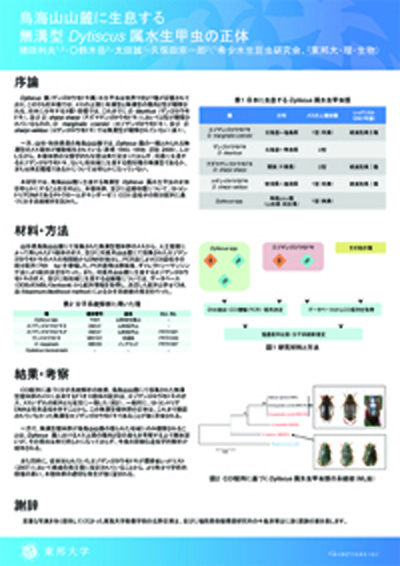 |
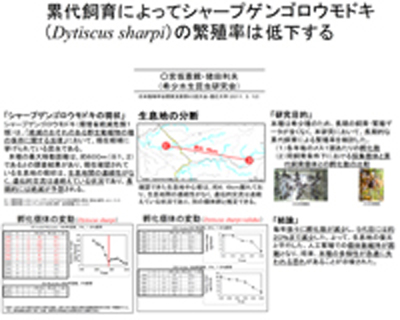 |
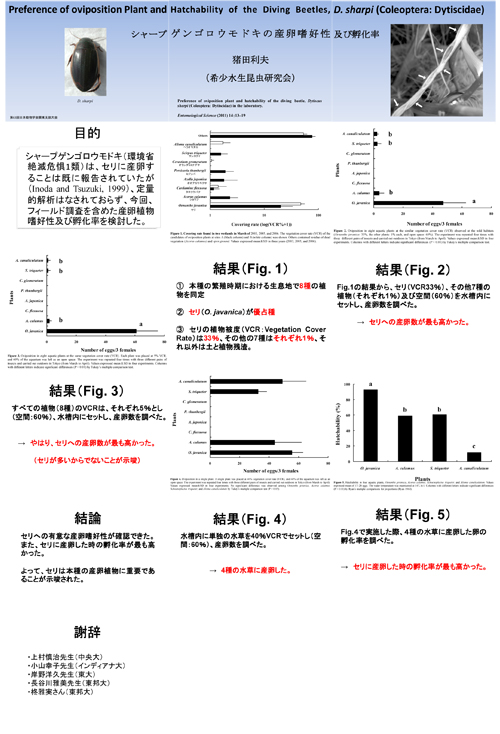 |
(March 16, 2015)
・ Our latest articles were published (See list of publications).
・ We had some presentations about insect reserch (See list of publications).
(April 13, 2013)
・ Our latest article was published online (See list of publications).
(September 04, 2012)
・ Our two latest articles were published (See list of publications).
・ We presented an international conference in Korea (See list of publications).
・ Content of Dytiscoidea was updated (here).
(May 24, 2012)
・ Our latest article was published online first (See list of publications). Since it is early view, the page and volume number are not allocated
yet.
・ Content of Dytiscoidea was updated (here).
・ 「お分けします」をアップデート(here)
(May 5, 2012)
・ Our latest article was published online first (See list of publications). Since it is early view, the page and volume number are not allocated
yet.
・ My co-workers and I presented 4 research articles at scientific meetings
(See list of publications).
(January 29, 2012)
・Our latest article was published online first (See list of publications). Since it is early view, the page and volume number are not allocated
yet.
・I updated our patent lists ((See list of publications)
・I updted Dytiscoidea.
(November 14, 2011)
・My co-workers and I presented 4 research articles at scientific meetings
(See list of publications). I introduced three posters of them related only for diving beetle research
below.
・I published the latest peer-review article (See list of publications).
 |
 |
 |
(December 30, 2010)
・My paper entitled "Preference of oviposition plant and hatchability of the diving beetle,
Dytiscus sharpi (Coleoptera: Dytiscidae) in the laboratory" now in press. It will be published online first (See list of publications).
・Our works under reviewing or in press are listed (See list of publications).
・Updated on 「ゲンゴロウモドキ属とは・・・」 (only Japanese)(See here)
(September 1, 2010)
・My paper entitled "Preference of oviposition plant and hatchability of the diving beetle,
Dytiscus sharpi (Coleoptera: Dytiscidae) in the laboratory" now in press. It will be published on line (See list of publications).
・Our works concerning skin whitening have opened in patent publication
(See list of publications).
・「動物学ひろば」にて発表します(東大・駒場)。今回は東海大学との共同発表です。一般向けの発表なので、皆様お誘い合わせのうえ、お越しください。第一線で活躍中の専門家と直接ディスカッションできる数少ない場でもあります。飼育方法から生態学、生理学、行動学、遺伝学等の専門知識のある者がおります。また、シャープゲンゴロウモドキの里親候補者も募集しておりますので、興味のある方は、会場でお声をかけてください。動物学ひろばの詳細は、こちらをご覧ください。
(March 13, 2010)
・My co-workers and I published our paper entitled "A preliminary note on the embryonic development of a diving beetle, Hydaticus pacificus Aubé (Insecta: Coleoptera, Dytiscidae)". (See list of publications).
・We presented species status of D. sharpi and D. sharpi validus based on mitochondria DNA sequences. (See list of publications).
In brief, we sequenced and compared 628bp of CO1 of Japanese diving beetles, Dytiscus sharpi (Chiba) and Dytiscus sharpi validus (Ishikawa). Our DNA sequence data suggest presence of two species that
might however hybridize and should therefore be considered recently diverged
species. The most important result is the documented genetic divergence
between D. sharpi and D. sharpi validus. Even if species status might be contentious, our results show that “D. sharpi” and “D. sharpi validus” are evolutionarily significant units and thus well deserves conservation
efforts.
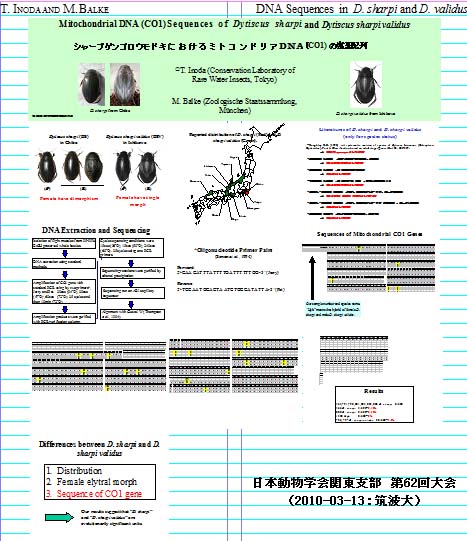 概略を記載します。
概略を記載します。
シャープゲンゴロウモドキは、関東産と関西産の亜種が存在するとか、1種であるとか、種の分類上の地位が不明瞭のままでした(環境省ではD. sharpi 1 種のみとして記載)。今回、我々は、異なる2産地から得た千葉県産シャープゲンゴロウモドキ(9個体)、石川県産シャープゲンゴロウモドキ(2個体)及び
千葉県産と石川県産との交雑個体(1個体)を用いて(いずれも繁殖個体)、ミトコンドリアの遺伝子であるチトクロームCオキシダーゼ1(CO1)の塩基配列(628塩基対)を解読しました。
ゲンゴロウ類で確認できている(M.Balke、未発表データ)、種レベル以上の変異が千葉県産と石川県産の個体との間に認められました。また、千葉県産
の個体間においては、2個体が種レベル以下での違いがありました。両個体群は、遺伝学的にそれぞれ"進化的重要単位"(Evolutionarily
significant unit)であることが示唆されました。また交雑実験及び交雑種のCO1塩基配列の結果から、両個体群は容易に交雑することも確認できたため
(haplotypeとして100%移行)、わりと近年、種分化したことが推測されました。従って、生態も異なる可能性があり、別個に保全する必要性があると考えられます。
なお、本研究においては、多くの方々の協力があっての成果です。この場を借りて感謝致します。ありがとうございました。
論文の謝辞には、その旨、記載予定です。
(October 3, 2009)
・I and my co-workers published our paper about diet of Dytiscus sharpi larvae (See list of publications).
larvae to have access to tadpoles of the proper size and amounts, depending on their growth stage.
(July 17, 2009)
・I presented my reserch concerning diet of Dytiscus sharpi larvae at the scientific meeting in Saitama city entitled "Dietary
program for rearing the larvae of a diving beetle, Dytiscus sharpi (Wehncke), in the laboratory (Coleoptera: Dytiscidae)" (See list of publications).
・New two scientific papers are in press. One is about diet for D. sharpi and the other is study on early embryonic development in H. conspersus (See list of publications)
・Japanese only.
誠文堂新光社より、「いきものもどき」と言う本が出版されました(山本紳一郎 著)。サソリモドキーサソリ、アリーアリモドキと言うようなモドキと名のつ
く動植物約100種を本家本元と対比しながら詳しく解説した本です。私はこの本の中に登場しているシャープゲンゴロウモドキの写真を提供しました(研究業績参照)。
・Japanese only. シャープゲンゴロウモドキを無償で提供します。条件は以下の通りです。提供血統、提供個体数、提供時期等は、要望にお答えできない場合もあります。詳細はメールでお問い合わせください。
1. 高等学校等の生物部等の学校関係者であること。
2. 飼育繁殖等は原則として、学校で行うこと。
3. 研究等は希少水生昆虫研究会と共同で行う。
4. 研究成果(研究論文や特許出願等)は希少水生昆虫研究会と共同で発表すること。
5. 提供した生体並びにその子孫は無断で他人や他の機関に譲渡・販売しないこと。
6. 定期的に飼育状況を報告すること(維持個体数など)。
7. 希少水生昆虫研究会との間で個体の譲渡・交換を必要に応じて行うこと。
(December 25, 2008)
・We presented the diving beetle reserch at a scientific meeting. (See list of publications).
・My children and I collected some wild Dytiscus sharpi
on November and December in new habitats in Chiba. I hope that I try to
breed new generation derived from new habitats we found.
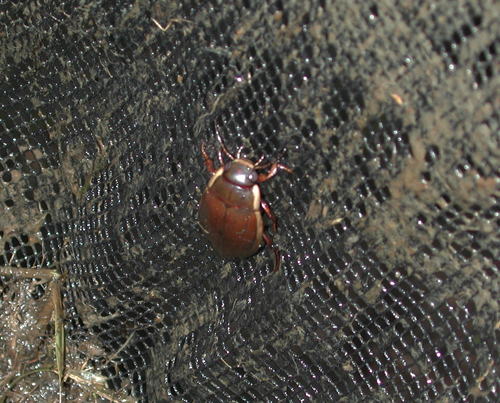 |
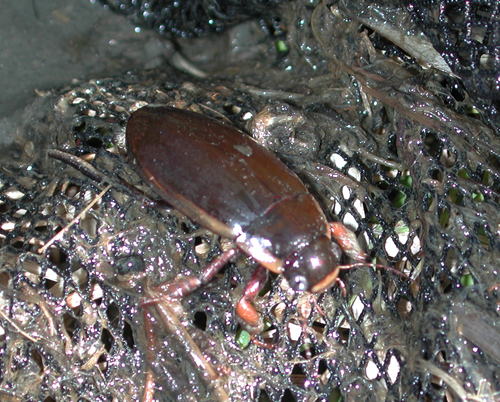 |
| A wild female of D. sharpi collected on November, 2008 |
A wild male of D. sharpi collected on December, 2008 |
(July 19, 2008)
・I published the errata of my recent publication appeared in Zool. Sci. 24: 1115-1121, 2007 (by Inoda et al.). A university professor in Israel pointed out our misleading description. When you read this article, please read the errata together. (See list of publications).
(May 6, 2008)
・In this homepage, I edited the scientific name of giant water bug, 'Lethocerus deyrolli' to 'Kirkaldyia deyrolli' according to the paper by P. J. P. Goodwyn (2006).
・Now I keep many larvae of Dytiscus sharpi and Dytiscus sharpi validus. Almost larvae grow to 3rd instars and 10-20 larvae made pupal chamber
now. In this season, I studied new breeding methods. One of them is to
development an artificial diet, not living creatures like tadpoles.I hope
that the new diet contributes to development a perfect captive breeding
system without wasting natural resources.
 |
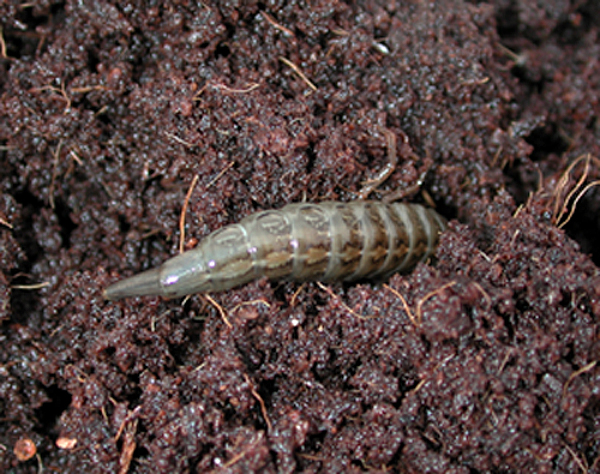 |
| Almost larvae of D. sharpi here will prepare to pupate soon (May 2). Of course, I have a lot of other nymphs at all stages now. |
Third larva is digging up (May 2). |
(Apr 14, 2008)
・We presented our new reserch entitled "The inheritance of intrasexual
dimorphism in female diving beetles, Dytiscus sharpi" at the annual scientific meeting. It is known that female Dytiscus
have usually clear grooves on their elytra. However, more than half of
the genus, show two types of the traits, grooved or smooth on female
back. We studied how these traits caused environmental or genetic
backgrounds. And if the trait determine genetically, which trait
dominant or recessive. This is our main interest in this study. We
investigated it by using Japanese species, Dytiscus sharpi, and amazing methods to prove it (See list of publications).
・The page in Hydaticus conspersus were updated (See Dytiscoidae).
(Feb 23, 2008)
・Our paper entitled "Temperature-dependent regulation of reproduction in the diving beetle Dytiscus sharpi (Coleoptera: Dytiscidae)" were finally published in the Zoological Science. I struggled completion
of the paper for a long time. We have found in scientifically interesting
findings included in physiology of endangered species. I am sure that this
study will provide for your suggestive breeding program in Dytiscus sharpi (See list of publications).
In this paper, we clarified that temperature regulated the mating behavior,
development of gonads, maturation of germ cells and egg spawning of both
female and male adults of predacious diving beetle. Mating behavior, gonads
and sperm maturation were observed around 20℃, however, egg maturation
needs additional exposure to temperature lower than 8℃. Photoperiod condition
was not important. Therefore, we conclude that the termination of reproductive
diapause is regulated in a temperature dependent manner, interestingly
in two steps. This would be related to the adaptation to southern warm
habitats of the species that had presumably derived from northern areas.
The points we would like to stress are,
1. The first clear description of reproductive diapause in Dytiscidae by temperature.
2. We show that summer reproductive diapause is controlled in two steps
by temperature.
3. We demonstrate that there are differences of threshold temperature between male and female on diapause breakdown.
(May 13, 2007)
From now, I decided that the corner of topics described all in English
because I wanted to inform the valuable information all over the world.
・I had met Dr. Roger Hardling from Sweden. He visited in my home and looked
at my breeding system in detail. I hope he will be able to achieve his
breeding there.
Then we had discussed the study of diving beetles concerining with female
morph. Now I am preparing the manuscript and we hope the study will publish
in few years. I am collecting a lot of data.
・I had talked about right handed snail eater : water scavenger, are an
unique insect that have asymmetric mangibles at Toho University as a
invited lecture (See list of publications).
・We have published a commercial publicartion which is related to my occupation (See list of publications).
・Now, I keep a plenty of larvae of D. sharpi including a variety of strains. I think it is almost over in this season,
however, I obtained a many older larvae and pupae including new born adults.